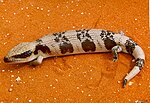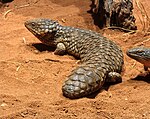Superregnum: Eukaryota
Regnum: Animalia
Subregnum: Eumetazoa
Cladus: Bilateria
Cladus: Nephrozoa
Superphylum: Deuterostomia
Phylum: Chordata
Cladus: Craniata
Subphylum: Vertebrata
Infraphylum: Gnathostomata
Superclassis: Tetrapoda
Cladus: Reptiliomorpha
Cladus: Amniota
Classis: Reptilia
Cladus: Eureptilia
Cladus: Romeriida
Subclassis: Diapsida
Cladus: Sauria
Infraclassis: Lepidosauromorpha
Superordo: Lepidosauria
Ordo: Squamata
Subordo: Scincomorpha
Superfamilia: Scincoidea
Familia: Scincidae
Subfamilia: Egerniinae
Genus: Tiliqua
Species (7): T. adelaidensis – T. gigas – T. multifasciata – T. nigrolutea – T. occipitalis – T rugosa – T. scincoides
Name
Tiliqua Gray, 1825: 201
Type species: Lacerta scincoides White, 1790, by subsequent designation.
References
Primary references
Gray, J.E. 1825. A synopsis of the genera of reptiles and Amphibia, with a description of some new species. Annals of Philosophy Série 2, 10: 193–217. BHL
Links
Uetz, P. & Hallermann, J. 2021. Tiliqua . The Reptile Database. Accessed on 29 October 2019.
Tiliqua – Taxon details on Interim Register of Marine and Non-marine Genera (IRMNG).
Tiliqua – Taxon details on Integrated Taxonomic Information System (ITIS).
Vernacular names
Deutsch: Blauzungenskinke
English: Blue-tongued Lizards
日本語: アオジタトカゲ属
Nederlands: Blauwtongskinken
ไทย: จิ้งเหลนลิ้นสีน้ำเงิน, บลูทั้งค์
Blue-tongued skinks[2] comprise the Australasian genus Tiliqua, which contains some of the largest members of the skink family (Scincidae). They are commonly called blue-tongued lizards or simply blue-tongues or blueys in Australia. As suggested by these common names, a prominent characteristic of the genus is a large blue tongue that can be bared as bluff-warning to potential enemies. Depending on the type of predator/threat that is near will determine the intensity of color present in the tongue. In addition, their blue tongue will produce a response in the prey which will in turn diminish the attack.[3] The tongue also can also deform itself and produce a thick mucus in order to catch prey. They are relatively shy in comparison with other lizards, and also significantly slower due to their short legs.
Systematics and distribution
Blue-tongued skinks are closely related to the genera Cyclodomorphus and Hemisphaeriodon. All species are found on mainland Australia with the exception of Tiliqua gigas, which occurs in New Guinea and various islands of Indonesia. One subspecies of Tiliqua scincoides is also found on several small Indonesian islands between Australia and New Guinea. Tiliqua nigrolutea is the only species present in Tasmania. With the exception of the pygmy blue-tongue, they are relatively large lizards (up to 45 cm total length), light-bodied, short-limbed, broad with distinct heads and dull teeth.
Ecology
Most species are diurnal, ground-foraging omnivores, feeding on a wide variety of insects, gastropods, flowers, fruits and berries.[4] The pygmy blue-tongue is again the exception, being primarily an ambush predator of terrestrial arthropods.[5] All are viviparous, with litter sizes ranging from 1-4 in the pygmy blue-tongue and shingleback to 5-24 in the eastern and northern blue-tongues.[6]
Species
| Name | Scientific Name | Picture | Subspecies |
|---|---|---|---|
| Adelaide pygmy blue-tongue skink | T. adelaidensis (Peters, 1863) | ||
| Indonesian blue-tongued skink | T. gigas (Schneider, 1801) |  |
T. g. gigas, Giant blue-tongued skink; T. g. evanescens, Merauke blue-tongued skink; T. g. keyensis, Key Island blue-tongued skink |
| Centralian blue-tongued skink | T. multifasciata (Sternfeld, 1919) |  |
|
| Blotched blue-tongued skink | T. nigrolutea (Quoy & Gaimard, 1824) |  |
|
| Western blue-tongued skink | T. occipitalis (Peters, 1863) |  |
|
| Shingleback | T. rugosa (Gray, 1825) |  |
T. r. aspera, Eastern shingleback; T. r. konowi, Rottnest Island shingleback; T. r. palarra, Shark Bay shingleback; T. r. rugosa, Common shingleback |
| Common blue-tongued skink | T. scincoides (White, 1790) |  |
T. s. chimaerea, Tanimbar blue-tongued skink; T. s. intermedia, Northern blue-tongued skink; T. s. scincoides, Eastern blue-tongued skink |
| Irian Jaya blue-tongued skink | Tiliqua sp. |  |
Notes
Gray, J.E. (1825). A synopsis of the genera of reptiles and Amphibia, with a description of some new species. Annals of Philosophy 10:193—217. p. 201
Tiliqua, Reptile Database
Abramjan, Andran (2015). "Why is the tongue of blue-tongued skinks blue? reflectance of lingual surface and its consequences for visual perception by conspecifics and Predators". Pubmed. doi:10.1007/s00114-015-1293-4. PMID 26185113.
Cogger, H.G. (2000). Reptiles and Amphibians of Australia. Reed New Holland.
Department for Environment and Heritage > Pygmy Bluetongue Lizard - fact sheet Retrieved 18 July 2017
Turner, G. 2001. Keeping Bluetongue Lizards. Australian Reptile Keeper Publications.
References
Austin, J.J. & Arnold, E.N. (2006). Using ancient and recent DNA to explore relationships of extinct and endangered Leiolopisma skinks (Reptilia: Scincidae) in the Mascarene islands. Molecular Phylogenetics and Evolution 39(2): 503–511. doi:10.1016/j.ympev.2005.12.011 (HTML abstract)
Bull, C.M. (1988). Mate fidelity in an Australian lizard Trachydosaurus rugosus (Scincidae). Copeia 1987(3): 749-757.
Bull, C.M. (1990). Comparison of displaced and retained partners in a monogamous lizard Tiliqua rugosa. Australian Wildlife Research 17: 135-140.
Valentic, R.A. (1996). A prey record of the Eastern Blue-tongue Tiliqua scincoides for the common brown snake Pseudonaja textilis. Monitor 8(3): 155.
Retrieved from "http://en.wikipedia.org/"
All text is available under the terms of the GNU Free Documentation License

